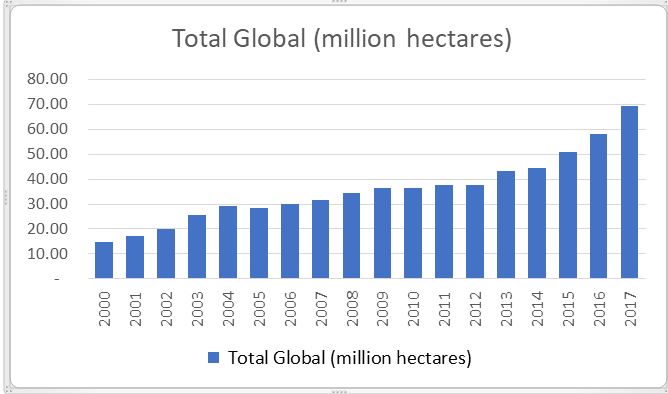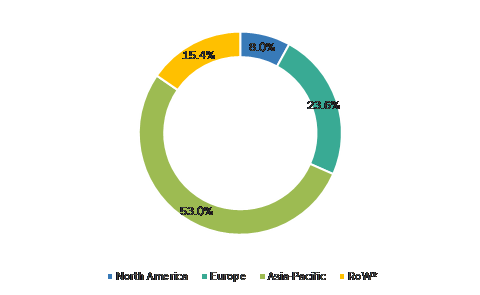The organic fertilizers market was valued at USD 5.87 billion in 2016. It is projected to grow at a CAGR of 12.08% from 2017, to reach USD 11.16 billion by 2022. According to the International Fertilizer Association, “fertilizers are any solid, liquid or gaseous substances containing one or more plant nutrients, which are either applied to the soil, directly on the plant (foliage) or added to aqueous solutions (fertigation), in order to maintain soil fertility, improve crop development, yield and crop quality.”
Organic fertilizers refer to those categories of fertilizers that are produced out of naturally derived components and have no inclusion of synthetic chemicals or materials in their preparation.
Increasing land area under organic cultivation
Globally, the agricultural land area under organic cultivation increased by a CAGR of 10.7% between 2000 and 2017, wherein it stood at about 69.2 million hectares in 2017, more than 1% of agricultural land globally.
This also denotes an addition of 11 million hectares or about 18.9% increase in 2017, over the 2016 levels.
To know about the assumptions considered for the study, download PDF brochure
Agricultural Land Area Under Organic Cultivation (2000–2017)

Source: Research Institute of Organic Agriculture (FiBL) Survey, 2017
From about 15 million hectares in the year 2000, the global agricultural land under organic cultivation increased to reach over 69.2 million hectares in 2017.
Agricultural Land Area Under Organic Cultivation, By Regional Share (2017)

*RoW includes South America, Africa, and the Middle East.
Source: Research Institute of Organic Agriculture (FiBL) Survey, 2017
An analysis of the individual regions suggests that out of a total of around 69.2 million hectares of agricultural land under organic cultivation globally, the Asia-Pacific region accounted for a share of about 53%, while Europe, RoW, and North America stood at around 25%, 15%, and 7%, respectively, in the year 2017.
Within the individual regions, the agricultural area under organic cultivation in the Asia-Pacific region increased by a CAGR of 10.7% during the period 2000–2017. Over the 2016 levels, the organic land area increased by around 11 million hectares or about 18.9%.
Similarly, the agricultural land area under organic cultivation in the North American and European regions increased by CAGRs of 8.7% and 8.0%, respectively, during the 2000–2017 period.
Advances in organic fertilizers’ manufacturing process
In the emerging economies, currently, the manufacturing of organic fertilizers is not mainstream, with still higher reliance on on-farm production of such fertilizers, using in-house composting and vermicomposting methods. The manufacturing of organic fertilizers in these regions also suffers from a lack of investment, which results in the utilization of outdated processes and equipment for the manufacturing process, and in turn, impacts the quality, quantity, and nutritional dynamics of the organic fertilizers so produced.
To speak to our analyst for a discussion on the above findings, click Speak to Analyst
However, due to significant developments in developed regions, including that of North America and Europe, the production of organic fertilizers is increasingly being commercialized and includes specialized production processes, techniques, and equipment. Here, all the stages of production are specialized and can be divided into several processes, such as:
- Compost stage (hydraulic compost turner)
- Raw material crushing (fertilizer crusher)
- Material mixing (fertilizer mixer)
- Fertilizer granulation (organic fertilizer granulator)
- Fertilizer drying and cooling (fertilizer dryer and cooler)
- Fertilizer packaging (automatic fertilizer packager)
This commercialization and specialization ensure economies of scale and capacity building, which result in ensuring the delivery of value-added products into the market. This, in turn, impacts the penetration or adoption rate of organic fertilizers and serves as the basis for which the increasing demand for organic fertilizers could be met effectively to cater to the growing demand for organic food, globally.